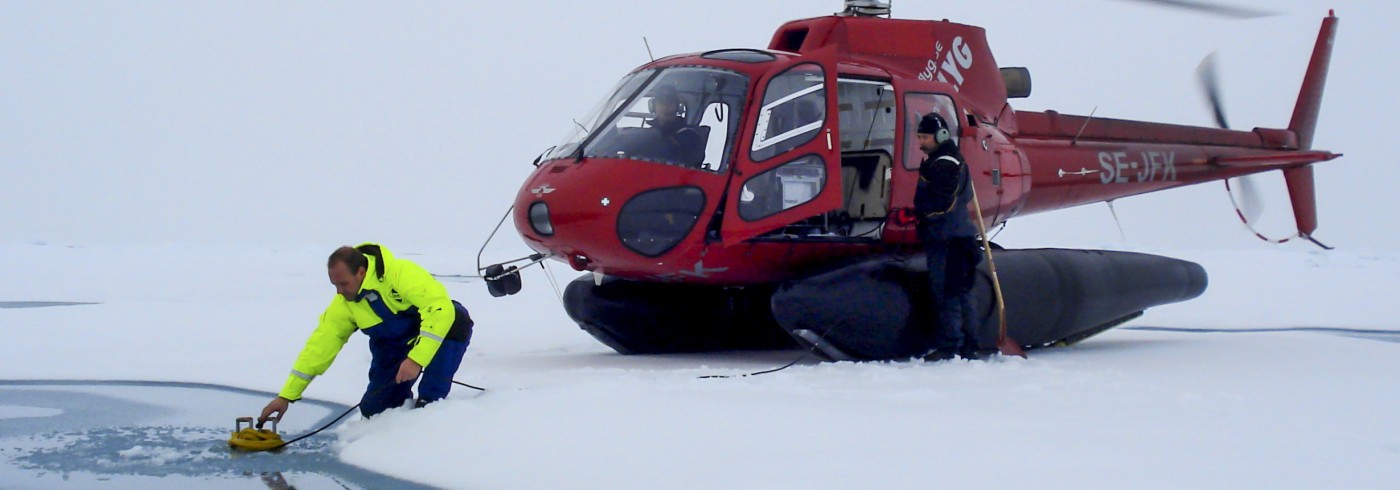Seismic data acquisition
31 July 2009 - 10 September 2009
3D view of the area covered by new multibeam bathymetric data. The International Bathymetric Chart of the Arctic Ocean (IBCAO ) is shown as background.
The second priority of the cruise was to acquire seismic data in the Amundsen and Makarov Basins on both sides of the Lomonosov Ridge (Figure 1). In order to work successfully in the harsh conditions, the seismic equipment had to be modified. These modifications were made in cooperation with the Department of Earth Sciences at the University of Aarhus, based on previous experience with data acquisition in ice-filled waters:
- The streamer is considerably shorter than in open water. For the LOMROG II cruise, a 250 m streamer was used. This enabled deployment and recovery while the ship was stopped, which significantly decreases the risk of damage.
- The seismic source is considerably smaller and more compact than for open water surveys. This simplifies deployment and recovery if the equipment has to be brought on board quickly.
- Streamer and airguns are towed at a depth of approximately 20 m (more than twice the normal depth), below the wash from the ship’s propellers, which are noise sources. A towing depth of 20 m also keeps the equipment from ice contact, where it can be pinched and damaged.
- Both airguns and streamer are connected with only one cable to the ship (the “umbilical”). This minimizes the risk of ice damage and simplifies a faster deployment and recovery
The seismic signals are recorded as the time it takes for energy to return to the surface from a subsurface reflector. Sonobuoys were deployed along the seismic lines to record the seismic signals at larger offsets. The buoys transmit the signals back to Oden, where the data are recorded. A new deployment technique was successfully developed: a 10 m rope was attached to the parachute of the buoy in order to prevent the buoy from surfacing.
Oden’s normal mode of operation under heavy ice conditions is to break ice at as high a speed as possible. If the ship gets stuck in the ice, normal procedure is to reverse and ram until the obstacle can be passed. However, this procedure is impossible with seismic gear behind the ship; the noise disturbs the data collection and the gear is sensitive to speed and risks getting trapped in the ice or tangled up in the propellers while reversing. To meet this challenge there are a number of options:
- In easier ice conditions, where Oden can break ice continuously at only 3 to 4 knots, seismic data of reasonable quality can be acquired. This is a particular challenge since UNCLOS requires data to be collected at a certain density. The ice conditions often prevented us from acquiring data where needed.
- Another option is to break a 25 nautical mile track by making two runs with Oden and subsequently acquiring the seismic data while passing through the track a third time (Picture 1). This option, suggested by the captain and the first mate of Oden, has some obvious advantages. Data quality is superior since Oden can maintain a more steady speed while the risk of losing/damaging the seismic gear is reduced. However, it is more time consuming.
- A third option is to use two icebreakers, as during LOMROG I in 2007. A powerful lead icebreaker breaks a track along a preplanned line. Oden trails behind acquiring seismic data. Augmented costs are partly compensated by faster and better data acquisition as well as providing the option to collect data along tracks longer than 25 nautical miles.
During the LOMROG II cruise a total of 380 km of seismic data were acquired, mostly by Oden using option 2 above. None of the seismic gear was lost in the ice and only one section of the streamer was damaged by the ice. In general data quality is better than that obtained during LOMROG I.


